
St Ives is a market town and civil parish in Cambridgeshire, England, 5 miles (8 km) east of Huntingdon and 12 miles (19 km) north-west of Cambridge. Historically in Huntingdonshire, St Ives is in the non-metropolitan district of the same name which covers a similar area to the historic county.

The River Great Ouse is a river in the United Kingdom, the longest of several British rivers called "Ouse". From Syresham in central England, the Great Ouse flows into East Anglia before entering the Wash, a bay of the North Sea. With a course of 143 miles (230 km), mostly flowing north and east, it is the fourth longest river in the United Kingdom. The Great Ouse has been historically important for commercial navigation, and for draining the low-lying region through which it flows; its best-known tributary is the Cam, which runs through Cambridge. Its lower course passes through drained wetlands and fens and has been extensively modified, or channelised, to relieve flooding and provide a better route for barge traffic. Though the unmodified river probably changed course regularly after floods, it now enters the Wash after passing through the port of King's Lynn, south of its earliest-recorded route to the sea.

Sutton or Sutton-in-the-Isle is village and civil parish in the county of Cambridgeshire in England, near the city of Ely. The "in-the-Isle" suffix refers to the fact that the village is part of the Isle of Ely, once an island in the Fens and also an administrative county until 1965.

March railway station is on the Ely–Peterborough line in the east of England and serves the town of March, Cambridgeshire. It is 85 miles 76 chains (138.3 km) measured from London Liverpool Street via Ely and is situated between Manea and Whittlesea stations.

Long Stanton railway station was a station on the Great Eastern Railway, between Cambridge and Huntingdon. It served the villages of Longstanton and Willingham, until closure in October 1970. The station was immortalised in 1964 in the song "Slow Train" by Flanders and Swann.
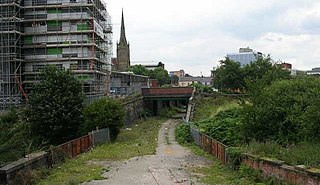
Maudland Bridge railway station was once the Preston terminus of the Longridge Branch Line, in Lancashire, England. It was located on Maudland Road, between a bridge over the Lancaster Canal and Cold Bath Street. The Maudlands district of Preston gets its name from the medieval St. Mary Magdalen's leper hospital, which once stood near the present-day St Walburge's Church.
The Ely and St Ives Railway was a railway company that opened a line between those places in 1878. It was an extension of the privately promoted Ely, Haddenham & Sutton Railway that had opened in 1866. It was a standard gauge single track. The line was worked by the neighbouring Great Eastern Railway but it was never profitable. The development of road transport services in the 1920s caused a steep decline in use of the line, and the passenger service was withdrawn in 1931. A goods service continued, but the line closed completely in 1964. No railway activity takes place on the route now.
The Cambridge and St Ives branch was a railway built by the Wisbech, St Ives & Cambridge Junction Railway in the late 1840s. The railway ran from Cambridge in the south, through Fenland countryside to the market town of St Ives; more specifically, the line ran from Chesterton Junction, where it met the present-day Fen line north of the River Cam.
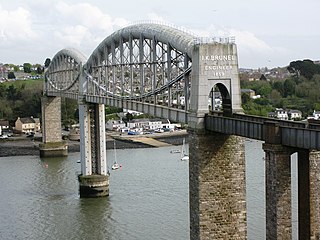
The Cornish Main Line is a railway line in Cornwall in the United Kingdom. It runs from Penzance to Plymouth, crossing from Cornwall into Devon over the famous Royal Albert Bridge at Saltash.

Earith is a village and civil parish in Cambridgeshire, England. Earith lies approximately 10 miles (16 km) east of Huntingdon. Earith is situated within Huntingdonshire which is a non-metropolitan district of Cambridgeshire as well as being a historic county of England. At Earith, two artificial diversion channels of the River Great Ouse, the Old Bedford River and the New Bedford River, leave the river on a course to Denver Sluice near Downham Market, where they rejoin the Great Ouse in its tidal part. At the 2001 census, the parish had a population of 1,677, reducing to 1,606 at the 2011 Census.
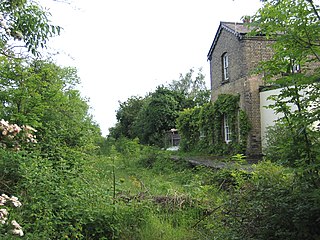
Oakington railway station was a station in Oakington, Cambridgeshire, on the line between Cambridge and St Ives. It opened in 1847 and was closed during the Beeching Axe in 1970. The station building remains as a private house but the track has been replaced by the Cambridgeshire Guided Busway.

Histon was the name of a railway station in Impington, Cambridgeshire on the Cambridge–St Ives branch of the Great Eastern Railway. The station was closed as part of the Beeching Axe in 1970; but the line through the station remained open for freight trains until the early 1992. The station site was partially demolished, with the platforms and a small building on the down side being removed and the canopy severely truncated during the construction of the Cambridgeshire Guided Busway but the station building was saved from being demolished; a car park was planned to be built on the site of the demolished station building.
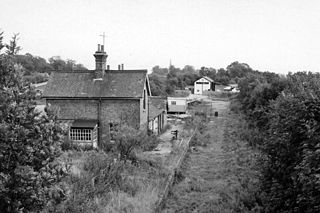
Bluntisham railway station was a station in Bluntisham, Cambridgeshire on the Ely and St Ives Railway. The station closed for regular passenger services in 1931 but was used for special excursion train until 1958 The station had a single platform, a signal box, and a goods shed on a loop.
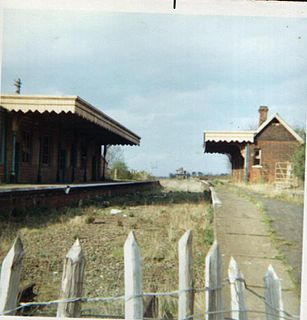
Somersham railway station was a station in Somersham, Cambridgeshire on the Great Eastern Railway between March and St Ives. There was also a branch line that ran north-west from the station to Ramsey. It opened in 1848, but was closed on 6 March 1967.
Sutton railway station was a station in Sutton, Cambridgeshire on the Ely and St Ives Railway.
Haddenham railway station was a station in Haddenham, Cambridgeshire. It was first opened in 1866 by the Ely, Haddenham and Sutton Railway. It closed to passengers in 1931 through it continued to be served by occasional passenger excursion trains until 1958 and goods trains until full closure in 1964.
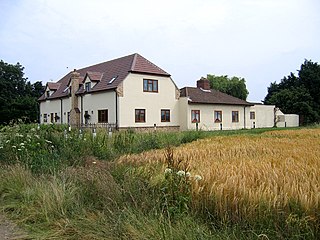
Wilburton railway station was a station in Wilburton, Cambridgeshire on the Ely and St Ives Railway. It was closed to regular passenger trains in 1931, excursion trains in 1958 and completely in 1964 along with the rest of the route.
Huntingdon East railway station served the town of Huntingdon, Cambridgeshire, England from 1883 to 1959 on the East Coast Main Line.
Presented below is an alphabetical index of articles related to Cornwall:












